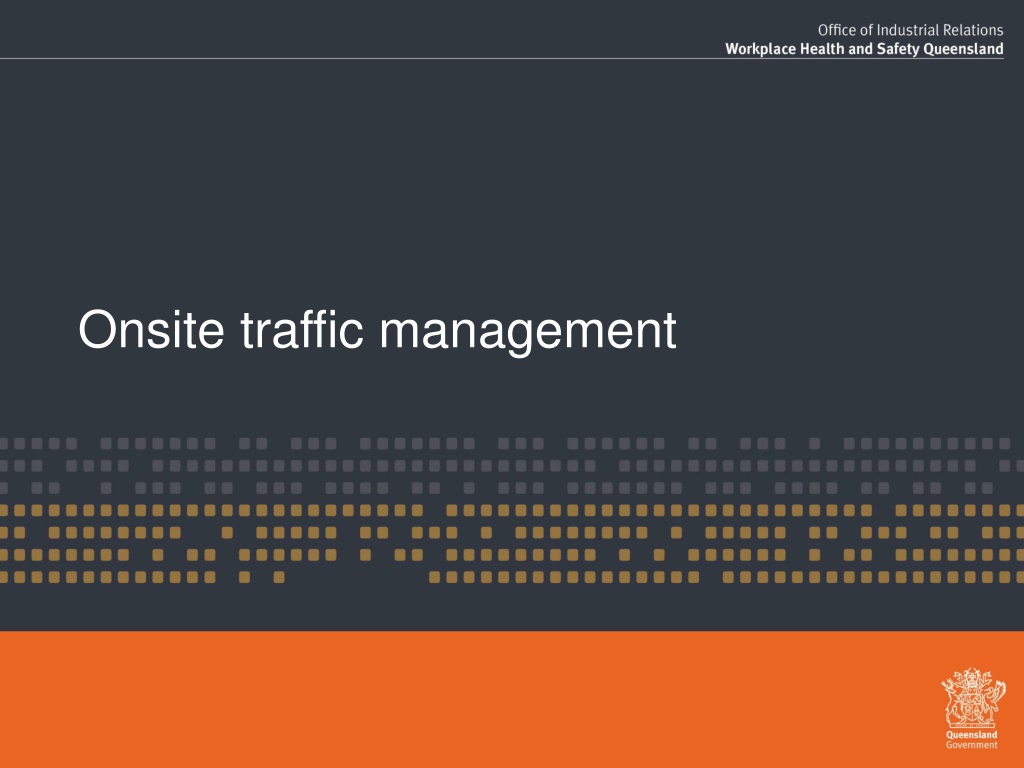Prioritizing Effective Traffic Management at the Workplace
Addressing the importance of traffic management as a top priority issue, the session aims to engage workers in assessing current practices, enhancing traffic management strategies, and improving safety measures to prevent incidents. The discussion focuses on key principles of controlling traffic risks, strategies to keep people and vehicles apart, setting up loading and unloading areas with pedestrian safety measures, and addressing critical considerations for site-specific traffic needs. By reinforcing effective communication and training, the goal is to develop a robust traffic management plan and prepare for emergencies to ensure a safe workplace environment.
Download Presentation

Please find below an Image/Link to download the presentation.
The content on the website is provided AS IS for your information and personal use only. It may not be sold, licensed, or shared on other websites without obtaining consent from the author. Download presentation by click this link. If you encounter any issues during the download, it is possible that the publisher has removed the file from their server.
E N D
Presentation Transcript
Aim of this session Discuss why traffic management is a priority issue for us. Consult with our workers on current workplace practices. Identify ways to improve our traffic management practices. Reinforce our systems for managing potential interactions between pedestrians and mobile plant. Outline next steps towards better traffic management practices at our workplace.
Incidents 2009-10 to 2014-15 (QLD) Generate discussion around current workplace practices
Controlling traffic risks key principles Keep vehicles and people apart. Limit vehicle movements or speed. Avoid the need for vehicles to reverse. Provide dedicated loading, unloading and parking areas. Provide a safe area for the driver. Provide clear signage road/area markings. Ensure effective workplace communication. Adapted from Safe Work Australia guidance material
Keeping people and vehicles apart Dedicated travel routes for plant, vehicles and pedestrians and physical barriers. Keeping pedestrians away from traffic flow altogether.
Loading and unloading areas Clearly designated pedestrian walkway protected by physical barriers with staggered barriers to control approaching pedestrians. Pedestrian exclusion zone has been established for a distance equal to the height of the load from the ground plus an additional allowance for the type of load. Beam from pedestrian-sensing device. Barriers, bollards, witches hats or paint marking the pedestrian exclusion zone. Warning light activated by pedestrian sensors. Establish a safety zone for the driver and other pedestrians if required to be present.
What issues do we need to consider? Understanding our site s traffic needs. Observing traffic flows and pedestrian behaviour. Managing our risks of people being hit by mobile plant or vehicles through site-specific controls: elimination substitution, isolation and engineering administration. Preparing for an emergency on our site. Providing information, training, instruction and supervision. Reviewing our traffic management plan.
Group discussion questions What traffic management practices at this worksite are working well? Have there been recent incidents either actual or near-misses? What factors were involved in these incidents? What situations create the greatest risk? How can we improve our traffic management practices?
Revising our traffic management plan Prioritise areas of risk at our workplace. ww Identify appropriate design controls. Revise our traffic management procedures. Provide refresher training and information. Allocate responsibility and dates for action.
Guidance Workplace Health and Safety Queensland Work Health and Safety Act 2011 Work Health and Safety Regulation 2011 Work Health and Safety Consultation, Co-operation and Co-ordination Code of Practice 2011 Traffic Management for Construction and Maintenance Work Code of Practice 2008 Managing the Work Environment and Facilities Code of Practice 2011 Onsite traffic management self-assessment tool Safe Work Australia General guide for workplace traffic management Traffic hazard checklist Traffic management guide for construction work
For more information www.worksafe.qld.gov.au Call 1300 362 128 Email safe@justice.qld.gov.au

 undefined
undefined

 undefined
undefined























